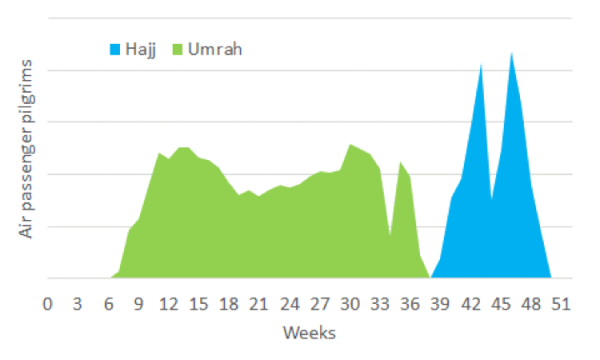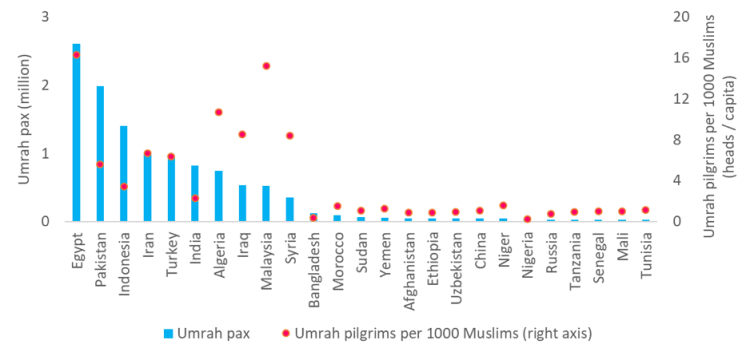In Saudi Arabia, religious tourism takes a turn
The pilgrimage to Mecca and Medina, called the ‘Hajj’ is one of the five pillars of Islam. All able Muslims must make the pilgrimage at least once in their lifetime.
Historically, this journey was a huge undertaking: travel was time-consuming, expensive, and rife with safety and security challenges for pilgrims. Modern amenities and technology have alleviated some of these challenges. Thanks to air travel, getting to Mecca is now quick, safe, and relatively more affordable.
But the modern era has also created new challenges. The number of Muslims worldwide has grown to approximately 1.6 billion. Meanwhile, the rituals of Hajj are still concentrated into just a couple of weeks each year. Consequently, if all the Muslims did the Hajj once in their lifetime, there would be approximately 25 million people visiting Mecca every year during the Hajj period.
The privatisation of Medina Airport proved to be a huge success leading to significant infrastructure investment by the TIBAH Consortium and making the airport an attractive entry point for pilgrims.
Even as the Saudi government invests heavily in infrastructure to support the influx of religious pilgrims, the physical capacity of the holy sites in Mecca can “only” accommodate approximately 2.5 million pilgrims. The infrastructure around the holy sites (e.g. roads, hotels, parking space, etc.) is bound by limitations as well. Given these constraints, the Saudi government must limit the count of Hajj pilgrims through a strict pilgrim Visa regime, which allocates quotas to each Muslim country.
For each country, the current quotas mandate a ratio of 1000 Hajj visas for every 1 million Muslims. In short, the average Muslim has less than 1 in 10 chance to perform a Hajj in his or her lifetime.
Even these capped numbers, however, pose particular challenges to operators of the infrastructure, including airports and airlines (Exhibit 1).
Exhibit 1 – Illustrative distribution of foreign pilgrim air passengers during the year

Source: Saudi GACA airport statistics, ICF analysis
The Hajj dictates that the pilgrims need to be in Mecca by the time the holy week begins. As a result, we see a surge in pilgrim travel during the 30 days before the Hajj. When the rituals conclude, the flow reverses. This “to-and-fro” motion exerts an extreme load on airport infrastructure and airline capacity, sparking very peaked and imbalanced traffic flows over a relatively short period of the year. This peak and the imbalanced flows translate into high prices for the pilgrims, while the infrastructure remains underutilised throughout the rest of the year.
Other Religious Observances Offer New Opportunities
While the attention of the public and the media is focused on the Hajj, the secondary pilgrimage to Mecca, called Umrah, offers untapped potential — and even solutions to the tourism challenges created by the Hajj. Umrah holds lower importance than Hajj in the religious sense, but a number of factors make Umrah more accessible for the average Muslim — and a potential boon for infrastructure operators.
Whereas the Hajj is obligatory, the Umrah is optional. There are also no strict rules with regards to the timing of the rituals during the Umrah, which means that pilgrims are free to perform the pilgrimage in the way and at the time that suits them best. As a result, pilgrim quotas aren’t required for the Umrah.
Because Umrah can be performed anytime, it also offers an opportunity for the operators to utilise the infrastructure more evenly throughout the year. Since the infrastructure is sized to support the Hajj, it offers ample capacity for Umrah pilgrims.
We estimate that Umrah pilgrims currently spend approximately $2.3 billion USD on air travel, compared to approximately $1 billion USD spent by Hajj pilgrims.
There’s also plenty of demand among religious travellers. The number of Umrah pilgrims (both domestic and foreign) is already ten times bigger than that of the Hajj pilgrims. In the absence of volume constraints, the number of Umrah pilgrims is expected to grow dynamically during the coming years. In fact, the Saudi 2030 Vision programme incorporates many elements that will aid the growth of this flow of visitors to the country, including (but not limited to) new airports as entry points for pilgrims.
So, from where do most of these pilgrims originate and where should operators focus their attention? Today, eight countries — Egypt, Pakistan, Indonesia, Iran, Turkey, India, Algeria, and Iraq — generate 90 percent of foreign Umrah pilgrims. Even among those countries, however, numbers of pilgrims (measured as pilgrims per Muslim capita) differs substantially (Exhibit 2).
Exhibit 2 – Estimated Umrah air passenger counts from top sending countries and the propensity to perform an Umrah

Source: ICF data collection
Having worked on multiple projects supporting Saudi religious tourism over more than a decade, ICF sees this sector moving into the next phase in its development. The first phase was about the expansion and modernisation of the infrastructure supporting the Hajj. The current phase is about continuing the expansion to support the Umrah as well. We expect the third phase to come and focus more on the logistical side of the pilgrimage. In other words, the time of expansionary growth will be followed by a time of improving intensity.
In the future, with the infrastructure readily available, investors will be turning towards making the pilgrimage a more affordable and better organised experience for the pilgrims. This includes elements like integrating ground transportation into pilgrim packages, speeding up border control, expanding the reach of the sales channels distributing the pilgrim packages, improving crowd control procedures, etc. The challenge in this third phase will be to develop good practices of cooperation between the private and the public sector who will be operating different elements of the overall value chain.